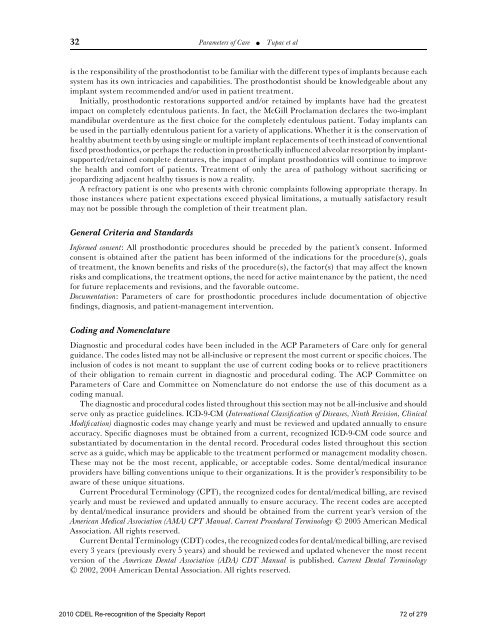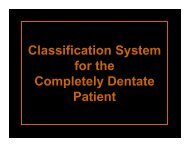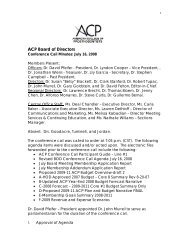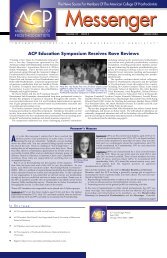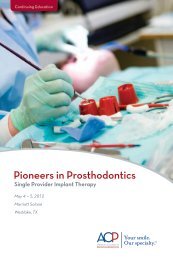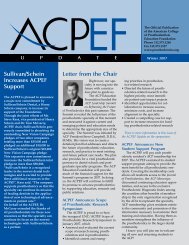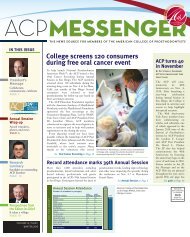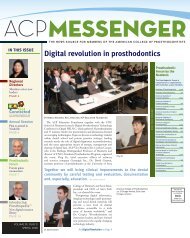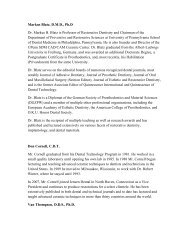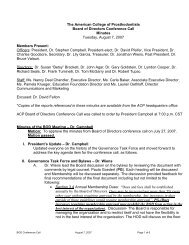PROSTHODONTICS - American College of Prosthodontists
PROSTHODONTICS - American College of Prosthodontists
PROSTHODONTICS - American College of Prosthodontists
Create successful ePaper yourself
Turn your PDF publications into a flip-book with our unique Google optimized e-Paper software.
32 Parameters <strong>of</strong> Care Tupac et alis the responsibility <strong>of</strong> the prosthodontist to be familiar with the different types <strong>of</strong> implants because eachsystem has its own intricacies and capabilities. The prosthodontist should be knowledgeable about anyimplant system recommended and/or used in patient treatment.Initially, prosthodontic restorations supported and/or retained by implants have had the greatestimpact on completely edentulous patients. In fact, the McGill Proclamation declares the two-implantmandibular overdenture as the first choice for the completely edentulous patient. Today implants canbe used in the partially edentulous patient for a variety <strong>of</strong> applications. Whether it is the conservation <strong>of</strong>healthy abutment teeth by using single or multiple implant replacements <strong>of</strong> teeth instead <strong>of</strong> conventionalfixed prosthodontics, or perhaps the reduction in prosthetically influenced alveolar resorption by implantsupported/retainedcomplete dentures, the impact <strong>of</strong> implant prosthodontics will continue to improvethe health and comfort <strong>of</strong> patients. Treatment <strong>of</strong> only the area <strong>of</strong> pathology without sacrificing orjeopardizing adjacent healthy tissues is now a reality.A refractory patient is one who presents with chronic complaints following appropriate therapy. Inthose instances where patient expectations exceed physical limitations, a mutually satisfactory resultmay not be possible through the completion <strong>of</strong> their treatment plan.General Criteria and StandardsInformed consent: All prosthodontic procedures should be preceded by the patient’s consent. Informedconsent is obtained after the patient has been informed <strong>of</strong> the indications for the procedure(s), goals<strong>of</strong> treatment, the known benefits and risks <strong>of</strong> the procedure(s), the factor(s) that may affect the knownrisks and complications, the treatment options, the need for active maintenance by the patient, the needfor future replacements and revisions, and the favorable outcome.Documentation: Parameters <strong>of</strong> care for prosthodontic procedures include documentation <strong>of</strong> objectivefindings, diagnosis, and patient-management intervention.Coding and NomenclatureDiagnostic and procedural codes have been included in the ACP Parameters <strong>of</strong> Care only for generalguidance. The codes listed may not be all-inclusive or represent the most current or specific choices. Theinclusion <strong>of</strong> codes is not meant to supplant the use <strong>of</strong> current coding books or to relieve practitioners<strong>of</strong> their obligation to remain current in diagnostic and procedural coding. The ACP Committee onParameters <strong>of</strong> Care and Committee on Nomenclature do not endorse the use <strong>of</strong> this document as acoding manual.The diagnostic and procedural codes listed throughout this section may not be all-inclusive and shouldserve only as practice guidelines. ICD-9-CM (International Classification <strong>of</strong> Diseases, Ninth Revision, ClinicalModification) diagnostic codes may change yearly and must be reviewed and updated annually to ensureaccuracy. Specific diagnoses must be obtained from a current, recognized ICD-9-CM code source andsubstantiated by documentation in the dental record. Procedural codes listed throughout this sectionserve as a guide, which may be applicable to the treatment performed or management modality chosen.These may not be the most recent, applicable, or acceptable codes. Some dental/medical insuranceproviders have billing conventions unique to their organizations. It is the provider’s responsibility to beaware <strong>of</strong> these unique situations.Current Procedural Terminology (CPT), the recognized codes for dental/medical billing, are revisedyearly and must be reviewed and updated annually to ensure accuracy. The recent codes are acceptedby dental/medical insurance providers and should be obtained from the current year’s version <strong>of</strong> the<strong>American</strong> Medical Association (AMA) CPT Manual. Current Procedural Terminology C○ 2005 <strong>American</strong> MedicalAssociation. All rights reserved.Current Dental Terminology (CDT) codes, the recognized codes for dental/medical billing, are revisedevery 3 years (previously every 5 years) and should be reviewed and updated whenever the most recentversion <strong>of</strong> the <strong>American</strong> Dental Association (ADA) CDT Manual is published. Current Dental TerminologyC○ 2002, 2004 <strong>American</strong> Dental Association. All rights reserved.2010 CDEL Re-recognition <strong>of</strong> the Specialty Report 72 <strong>of</strong> 279


